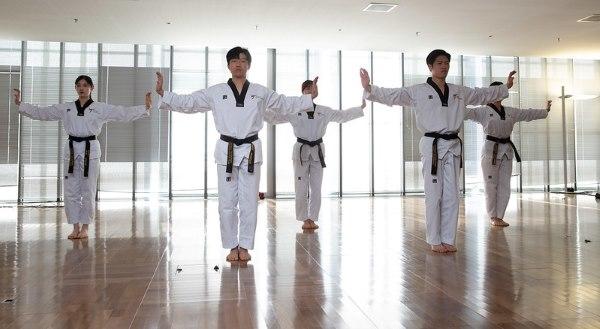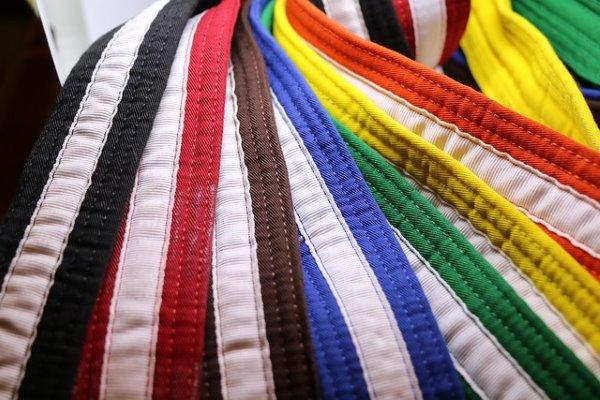Tang Soo Do Vs. Taekwondo both roots back to ancient Korean Martial Arts. Due to their common Korean Heritage, both Martial arts styles share some training methodologies, including Kicking techniques, Self-defense strategies, and ranking systems.
Although united by the underlying principle of Martial Arts, both styles have developed some distinct differences over time. The most considerable differences are the use of weapons, and the energy requirement for Tang Soo Do vs. Taekwondo.
Tang Soo Do combines traditional Korean and Chinese Martial Arts styles(Kung Fu). On the other hand, Taekwondo is a blend of Japanese Karate with Korean and Chinese Martial Arts.
Let s explore the history, techniques, benefits, and characteristics of Tang Soo Do Vs. Taekwondo in more detail to gain a better understanding of these two Martial Arts.

Table of Contents
ToggleThe Korean Martial Arts Heritage
The Decline of Korean Martial Arts
The Korean invasion by Japan in the early 20th Century led to the downfall of Martial Arts training. The liberation of Korea from Japanese occupation after the Second World War, led to the resurgence of interest in Korean Martial Arts.
The Evolutionary Journey of Taekwondo
The evolutionary history of taekwondo roots back to the Three Kingdom Era of the Korean dynasty. Back in time, this martial Art was practiced with an old style and identity. However, the old unmodified styles of Taekwondo are Subak, Taekkyon, Gwonbeop, and many others.
The evolutionary blend of Traditional Korean Martial Arts and Chinese Martial Arts with the influence of Japanese Karate led to the emergence of new Martial Art named Taekwondo.
The Inspiring History of Tang Soo Do
The Tang Soo Do history shows that traditional Martial Arts training was restricted during the Japanese occupation period.
Soo Bahk Ki, and Soo Bahk Do are previous and unmodified Tang Soo Do Martial Art styles practiced by the military during the Three Kingdom Era. Tang Soo Do is a blend of Chinese Martial Arts, such as Kung Fu and Shotokan Karate, with Traditional Korean Martial Arts.
Establishment of Kwans
Several Martial Arts Kwans (training institutes) were established in Korea after World War II. The purpose was to develop and standardize Tang Soo do and Taekwondo. Moo Duk Kwan, Song Moo Kwan, and Chang Moo Kwan are famous Martial Arts institutes.
Tang Soo Do vs. Taekwondo-Comparative Analysis
| Aspect | Tang Soo Do | Taekwondo |
| Origin | Korea | Korea |
| Founder | Hwang Kee | Choi Hong Hi |
| Meaning of Name | “Tang” represents the Tang Dynasty of China(known for its martial arts influence), while “Soo” means “hand,” symbolizing the hand techniques involved in the activity. | Tae” stands for Foot. while, “Kwon” stands for Fist, and “Do” stands for Way. The name emphasizes the involvement of hands and feet in the activity. |
| Techniques & Tactics | Kicks, punches, strikes are used in fighting strategy while blocks, throws, and joint locks for self-defense | It involves a strong emphasis on high, and fast leg kicks |
| Ranking System | Colored Belt ranking system for beginners Black Belt Ranking System for seniors. | Colored Belt ranking system for beginners while, Black Belt Ranking System for senior practitioners |
| Use of Weapons | Allowed | Not Allowed |
| Target Body Parts | Targets whole body | Targets the lower body |
Tang Soo Do vs. Taekwondo Fight
Which is More Demanding?
Unlike Tang Soo Do, Taekwondo is a demanding Martial art involving high jumping style leg kicks and fast responses. The acrobatic nature of Taekwondo requires muscular strength and athlete agility.
In contrast, Tang Soo Do is focused more on strikes, punches, joint locks, and throws. It involves fluid and more focused movements.
Tang Soo Do vs. Taekwondo- Techniques
Taekwondo’s Dynamic Kicks And Techniques
Unlike Taekwondo, the training principles of Taekwondo emphasize high-speed jumping strikes and spinning kicks. Although, there are numerous kicking styles but the most practiced Taekwondo kick names are mentioned below along with their explanation:
Front Kick (Ap Chagi)
The front kick is one of the Taekwondo 6 basic kicks. It involves extending the leg straight forward, raising the knee while, striking the target with the ball of the Foot. It targets the midsection and head of the opponent.
Side Kick (Yeop Chagi)
It involves striking the target with the heel by raising the knee to the side while extending the leg horizontally.
Roundhouse Kick (Dollyo Chagi)
A circular kick that focuses on swinging the leg in an arc. It involves striking the target with the ball of the Foot while, the leg is lifted, and the knee is bent.
Back Kick (Dwit Chagi)
The back kick is a powerful technique. It involves turning the body away from the target while kicking backward with the heel.
Hook Kick (Huryeo Chagi)
In the Hook Kick technique, we swing the leg in an arc, while the knee is bent. The Foot strikes the target with the heel or ball of the Foot.
Axe Kick (Naeryeo Chagi)
It is characterized by raising the knee while driving the heel toward the target. This kicking style targets the head or collarbone area.
Tang Soo Do Training
Although Tang Soo Do basics are similar to Taekwondo, there are some additional tactics practiced as well which include:
- Hand techniques include punches, strikes, and Blocks.
- Stances and footwork
- Self-defense techniques include joint locks, throws, and close-quarter strikes.
Why is Tang Soo Do effective?
In contrast to Taekwondo, Tang Soo Do puts more emphasis on learning self-defense skills. The tactical training in Tang Soo Do help us learn strategic decision-making. Just like Taekwondo, Tang Soo Do Martial Arts also plays a significant role in physical fitness and mental strength.
Tang Soo Do Vs. Taekwondo: The Art of Weaponry
Unlike Taekwondo, Tang Soo Do emphasize the use of weapons.
The suggested Tang Soo Do weapon list includes
- Dan Bong
- Nunchaku
- Boo Staff
- Sword
Tang Soo Do vs Taekwondo: The Sparring Strategy
Although sharing the same roots Tang Soo Do, and Taekwondo differ in their techniques, focus, and training methodologies.
Distance between the opponent
Taekwondo principles involve maintaining a long distance between opponents because of the quick and agile footwork involved. While in Tang Soo Do, practitioners play in a close range as a wide range of safe techniques is engaged.
Kicking Techniques
Taekwondo training involves dynamic and high-flying kicks. On the other hand, Tang Soo Do focus on a wide range of grappling techniques and hand strikes.
Defensive Strategies
Taekwondo’s defensive strategies include blocking and dodging while, Tang Soo Do includes direct blocking and counter-striking methods.
Sparring Gear
The Taekwondo and Tang Soo Do sparring gear is almost the same while, both require the use of the following protective equipment for safety:
- Hand and foot protectors
- Head Gear
- Mouth Guard
- Groin Protector
Tang Soo Do vs. Taekwondo: Ranks and Levels
Every Martial Art uses a ranking system to check its practitioner’s progression and skill level. The ranking criteria vary depending on the training and ranking organization.

Taekwondo Belt System
Taekwondo levels fall into three categories:
Gup
It is the most junior-colored ranking belt system. It has nine levels and is used to evaluate the performance of beginners.
Poom
This ranking system serves as a transitional phase between Gup and Dan. The practitioners can win the Junior Black belt after they have achieved all the Colored Belts while they are under the age of 15 years.
Dan
The highest ranking system provides the Black Belt to practitioners who have achieved Gup and Poom ranking system Belts. Furthermore, a practitioner must reach the age of 15 years to accomplish a Dan belt.
What is Tang Soo Do Belt System?
The Tang Soo Do ranks consist of ten colored belts to evaluate the performance of beginners. In contrast, Four Black belts are used to rank the progression of practitioners involved in the advanced stages of this Martial Art.
Hierarchy of Tang Soo Do Belt Levels
The Tang Soo Do belt order ascends from beginner-colored belts (Gup) to advanced-level Black Belts (Dan).
Tang Soo Do Vs. Taekwondo: Famous Federations
- Grandmaster Hwang Kee founded the Moo Duk Kwan organization in 1945, a significant “Tang Soo Do” Martial Arts association.
- In 1982, Grandmaster Jae Chul Shin founded World Tang Soo Do Association (W.T.S.D.A.).
- In 1996, General Choi Hong Hi founded The International Taekwon-Do Federation.
- World Taekwondo Europe (W.T.E.) arranges various Taekwondo events across European countries.
Conclusion
So, let’s conclude the above discussion while acknowledging that both Tang Soo Do and Taekwondo benefit us in numerous ways. Both Styles of Martial Arts have gained immense popularity and recognition worldwide.
However, deciding which Martial Arts is better depends upon individual preferences, goals, and body needs. If you want to pursue Olympic Martial Arts, it is essential to maintain proficiency in Taekwondo while Tang Soo Do is a Karate-based martial art.
Whether you choose Tang Soo Do or Taekwondo, engaging in these martial arts will lead to personal growth and physical fitness. So, let’s embrace the Martial Arts journey while embarking on the path that resonates with your goals.
Frequently Asked Questions
Which is more effective taekwondo or tang soo do?
Although, both martial arts offer different techniques and training methodologies, determining their effectiveness depends solely on individual preferences and goals.
Is Tang Soo Do a type of karate?
Tang Soo Do is a Korean Martial Art while, it has some influence from Japanese Karate.
What is the difference between Tang Soo Do and Taekwondo?
Tang Soo Do involves fluid body movement by the whole body. In contrast, Taekwondo involves more agile and high kicks by the lower body.